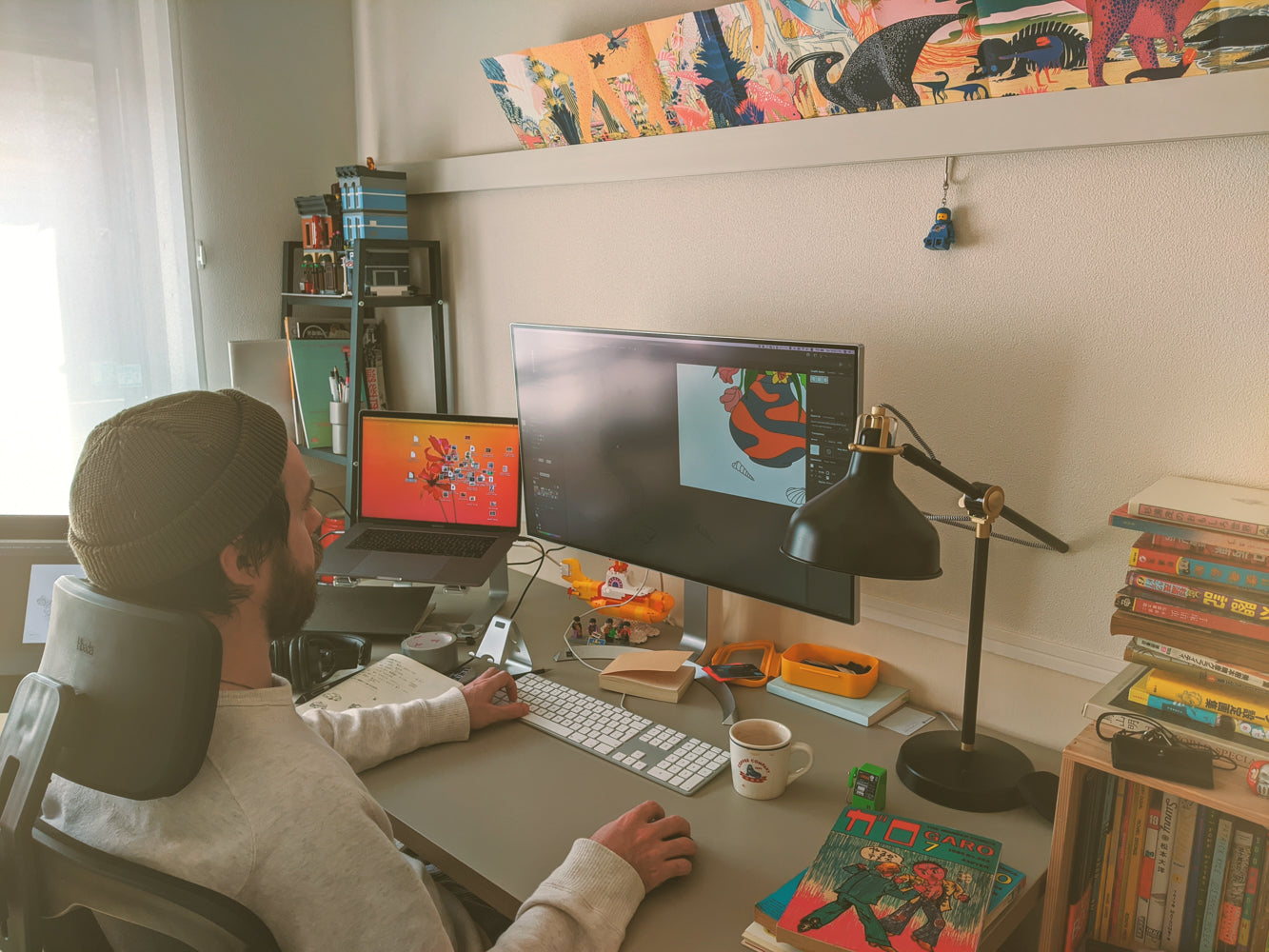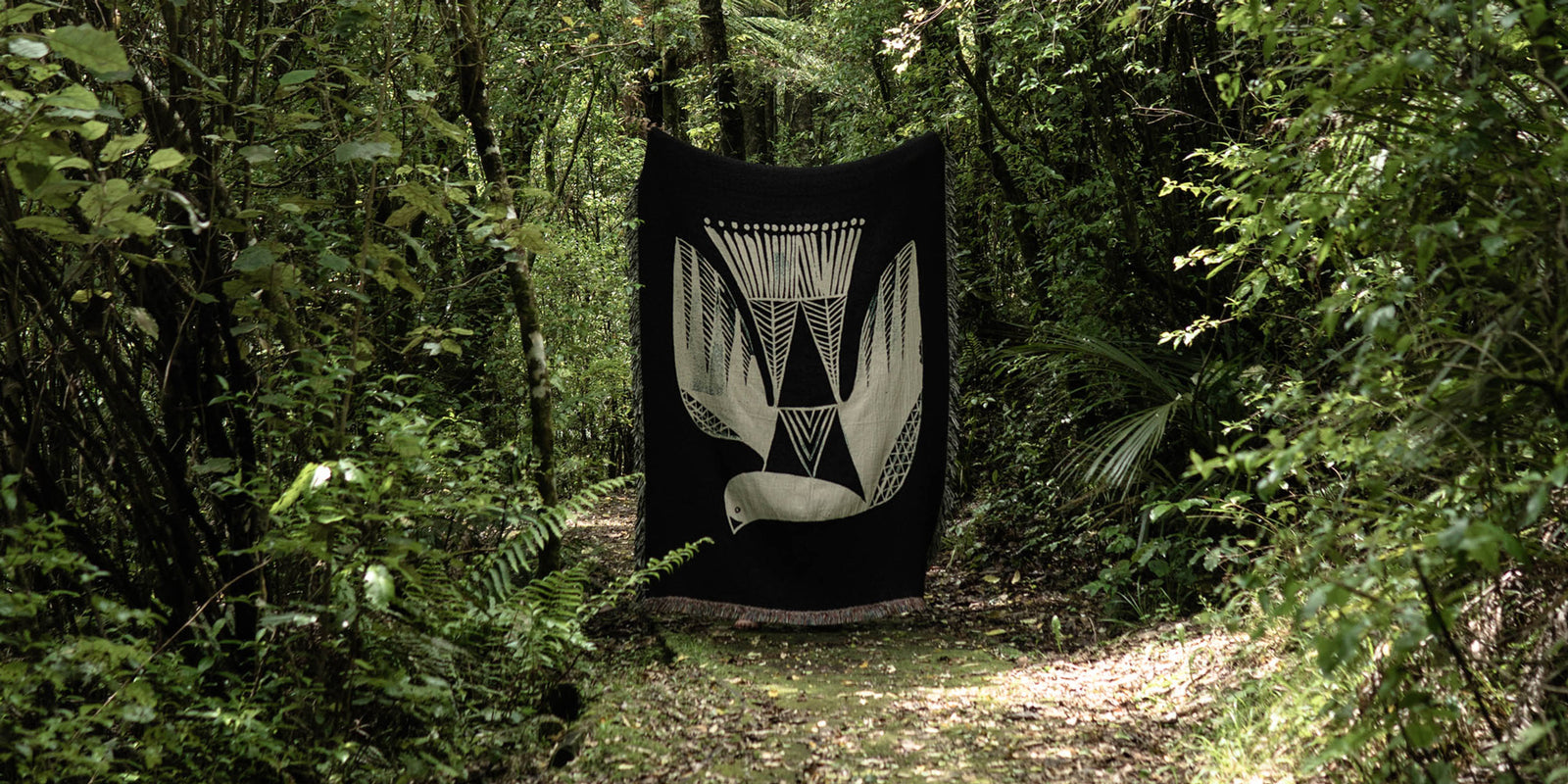Emile Holmewood is a graphic designer working and living in Tokyo, by way of London. Emile is pretty busy, often working across three time zones (Japan-10pm, London-2pm & New York-9am is the sweet spot), he recently became a dad and somehow he found the time to kindly reply to my back and forth emails. We "chatted" about how he ended up in Japan, what influences Tokyo has on his art, his favourite snack and of course LEGO.

Where are you from and what were you like as a kid?
I’m from Westport - the West Coast of the South Island. As a kid I was obsessed with LEGO and the Simpsons mostly. I drew a lot of comics about my cat, pirates or bases, I spent a bit of time building huts too. I wasn't into sports, which didn’t really bode well in Westport!




You live in Japan now and before that you were in London. What brought you to these cities?
I travelled around Europe in 2013, and settled in Hackney, London from 2014 to 2018. The appeal was lots of cheap, great gigs; bustling street food scene; nice parks, pubs and cafes. In a geeky way, one of my favourite things about London was the public transport.
I travelled around Europe in 2013, and settled in Hackney, London from 2014 to 2018. The appeal was lots of cheap, great gigs; bustling street food scene; nice parks, pubs and cafes. In a geeky way, one of my favourite things about London was the public transport.
I moved to Tokyo, as my girlfriend's (my now wife) British visa was expiring. Luckily I’m freelance, and had been planning to leave London anyway on account of rent. My dream had always been to live in Japan, (I was meant to make the move in 2011, but the earthquake prevented that.) The appeal of living here is pretty much everything. I love the yokochou (food alleys) the most; tiny hidden streets; old buildings; food; lovely (and polite) people. Tokyo is so vast that it offers endless exploration. Even though it’s the largest city in the world, it’s still incredibly quiet and immaculately clean (despite hardly any rubbish bins). Travelling around Japan is great too, and I definitely have a soft spot for Osaka.


What's your go to Japanese convenience store snack, drink?
チキ旨辛 - Chiki red (spicy fried chicken) Failing that, probably a Tuna and mayonnaise onigiri.
What does a typical day look like for you?
I’ve recently become a dad, so things have changed a bit in terms of working habits. Lately, after a night shift of feeding, I get up about 9.30 and start work at 10-10.30. If I don’t have commissioned work, I have plenty of personal projects to get through. I’ll work throughout the day–minus 1 hour in the middle to give my wife a break– till 6, when I put my daughter to bed. I sometimes need to be back to work from 10pm-midnight for any client calls and emails. Those hours might sound miserable, but I really love my job, so it doesn’t bother me.




What’s your background? Did you go to art school?
I studied graphic design at Massey, Wellington and from there worked at various studios and agencies in Auckland. I’d originally gone to Massey to study illustration and animation, but some tutors convinced me graphic design was a better choice (their argument, it’s easier to get work as a graphic designer that illustrates than an illustrator who does design). They were probably right too, and I’m glad I have a foundation in design that informs my approach.


How did you start your career as an artist?
So as a designer with an illustration offering, I was sometimes getting jobs that utilised that - although I was usually asked to imitate someone else’s style. So there was that. I didn't get started until I moved to London in 2013. I was really inspired by London’s happening illustration scene, there were lots of events and exhibitions celebrating it. The design job I landed was for a B2B agency, which took creativity to a whole new low, so as an outlet I took up screen printing at Londons Print club. The membership fee motivated me to produce works on a weekly basis, and my style was pretty influenced by the limits that would allow me to achieve that.


Can you describe your style and how you came to it?
I was wanting to produce a new screen print every weekend, so to make that feasible I needed the style to tick a few boxes:
Be bold, flat colours – working with halftones was beyond my technical ability. Have black outlines to trap the ink.
Originally drawn digitally (so I could sneak it in at work and also just print out the positives for exposing). Until recently I never drew pupils in my characters eyes - that was a trademark move to try and make my style ownable, but since moving to Japan have started to abandon that. After a while my job asked me to leave (somewhat bothered by my love of illustration?!) but luckily I had built up a portfolio of work, and my agent took me on.


What are the main themes/ideas in your art?
When I started, it was just meant to be a hobby on the side - I never thought I could do this for a living. So I was just drawing what interested me. Cowboys (I loved old western posters) and baroque themes from having access to Londons galleries. I thought it was funny to combine the two -baroque cowboys in an illustrated style. I’ve moved on from that now, and when I’m working on personal work I tend to just draw whatever’s interesting me at the time sometimes experimenting with something new. When I first moved to Japan, it was the old buildings. Lately I’ve been inspired by retro/vintage manga so am trying get a more retro look in my style and also drawing LEGO.
What is your process for creating a new artwork?
I tend to scribble or note little ideas I have when they pop into my head. If after a couple of days or weeks they still seem like an okay idea, I might try and realise them. I get bored quickly, so once I start, I try and finish an image within a few days.
I’m open to evolving my style, especially lately, as Japanese culture tightens it’s grip on me - so I absorb a lot of reference. I’ve been buying a lot a lot of old manga from the 60’s-80s lately, so often pondering ways I can let it influence my work.


What/who is your main source of inspiration?
My first big inspiration was Chris Ware for the style, and Norman Saunders and Paul Rubens for the subject matter. These days I’m looking at a lot of Akira Toriyama’s and Tezuka’s old works. The recent works I did for endemicworld are inspired by Patrick Caulfield and life (and tearooms) on the West Coast.
I see some similarities between your work and Japanese neon lights. Apart from the anime and manga influence how else has living in Japan influenced your work?
Generally retro culture. Old [showa era] buildings and collections on streets. I’ve become pretty attached, as every day an old building is being torn down and replaced by some dull, prefabricated eye sore. I try my best to document the good ones.




What materials do you like to work with you when creating your art?
I always have a sketchbook on my desk but my sketches would likely be indecipherable to anyone but me.
I’m predominantly digital, so for me it’s a matter of software. I draw in Adobe Illustrator, usually directly - then any areas I’m struggling with (usually hands) I might sketch in photoshop or procreate, then trace it in Illustrator. I also sometimes figure out compositions in 3D so I can play with different camera angles, and use that as a starting point.
As I lot of my work is often only existing digitally, I add some post effects like noise and blur to take off the sharp vector edge.
Where do you create your art?
On my MacBook, in my home studio, which I share with my cat.


What do you want people to think/feel when they see your art?
Right now, I’d like them to get a warm nostalgic feeling.
What are you working on right now?
I’m working on some Japanese themed beer cans, for a US client and, for another client some Japanese themed murals for a ramen shop opening in the US.
Personally, I have several LEGO themed illustrations on the go.


What are your plans for the future or something you would like to work on next?
I am planning to get back to some character designs (lately I’ve been drawing a lot of objects), and I’m always trying to make some time to learn more 3D.
Three words to describe your artwork.
Actionable hyperlocal clickbait






